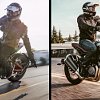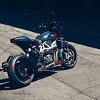At the tail end of 2024, Indian Motorcycle quietly shut down production of the FTR. You won’t find an official announcement on the company website. There was no press release addressing the decision. Instead, the model’s farewell was reduced to a footnote in a Polaris earnings presentation.
In 2018, three segments made up the American V-twin market: tourers, baggers, and cruisers. The Indian FTR 1200 was none of them. That’s what made the model so special. It was new. It was different. And it arrived with more buzz than any Indian model before it. Now, a mere six years later, Indian is sweeping it under the rug.
Needless to say, I had questions. So, I reached out to a brand representative for comment. IMC provided the following statement:
“Indian Motorcycle regularly reviews its portfolio — critically evaluating where to focus investments to have the biggest impact for riders, as well as position the brand for continued growth through the development of products that reflect emerging trends and rider preferences.
“After careful consideration, Indian Motorcycle made the decision to discontinue the FTR lineup. The decision aligns with Indian Motorcycle’s long-term vision to focus on models and technologies that represent the future of the brand, as FTR is a small part of Indian Motorcycle’s overall portfolio. The decision enables the brand to focus investments on platforms, as well as future products and technologies in the pipeline.”
You can distill that 104-word response down to one thing: FTR sales were weak. At least that’s what describing the model as a “small part of Indian Motorcycle’s overall portfolio” tells me. When it first came out, though, it seemed to promise more than that. It was the most exciting model in Indian’s lineup. That wasn't very long ago, either.

Here for a good time, not a long time
2018 was the year of the FTR. Jared Mees rode the Indian FTR750 to the AFT Twins championship. Motocross legend Travis Pastrana recreated Evel Knievel's record-breaking stunts aboard the same bike. By October, Indian announced the 2019 FTR 1200, a production model inspired by the title-winning FTR750.

All the momentum was on Indian’s side. Soon, one Spurgeon Dunbar would sing its praises. Common Tread alums Lemmy and Joe Zito even modded an FTR 1200 S for a RevZilla giveaway. Riders were buzzing about the new Indian. It wouldn’t last long.
After the initial burst of interest, the FTR 1200 struggled to attract a broader audience. That was due, in part, to its 18-inch wheels and DT3-R Dunlop rubber — two components that paid homage to the model’s dirt-tracking heritage but also placed the FTR at a disadvantage within the hyper-competitive naked bike class. It was also priced higher than most of those competitors.
With sales not living up to expectations, Indian rebranded the model in 2022. To use a race bike analogy, it went from resembling a flat-tracker to a Super Hooligan. It dropped the “1200” from its name. It adopted 17-inch hoops wrapped in Metzeler Sportec tires. A steeper rake, shorter trail, and fully adjustable suspension completed the sporty makeover. Tyler O’Hara’s back-to-back Super Hooligan National Championships (SHNC) in 2022 and 2023 only bolstered the renewed platform. Unfortunately, Super Hooligan raceway success didn't translate into showroom success any more than flat-track domination sold FTRs.

In the model's twilight years, Indian introduced two collaborative special-edition FTRs. First was the Championship Edition. Then came the FTR X 100% R Carbon and the FTR X RSD Super Hooligan edition. The latter was the final FTR variant released by the American OEM. In a year's time, the FTR would be discontinued.

Yes, the FTR failed, but it wasn’t for lack of trying. Indian first leaned into its flat-track lineage. Even though the FTR's life span mostly coincided with Indian's domination of AFT, that racing success didn't move the needle on sales. When the flat-track tie-in didn't gain traction, the FTR evolved into a naked bike, but sales still didn't take off. Then Indian released special editions, but special paint or bolt-on accessories couldn't save the model.
When the FTR first arrived, it offered something new. It offered something different. It was a motorcycle from a major U.S. manufacturer that wasn’t a tourer, bagger, or cruiser. Indian will reinvest in those three core segments in the FTR's absence. The American V-Twin landscape may include an adventure-tourer nowadays, but with the FTR's demise, the market still doesn't seem ripe for an American-made roadster.









